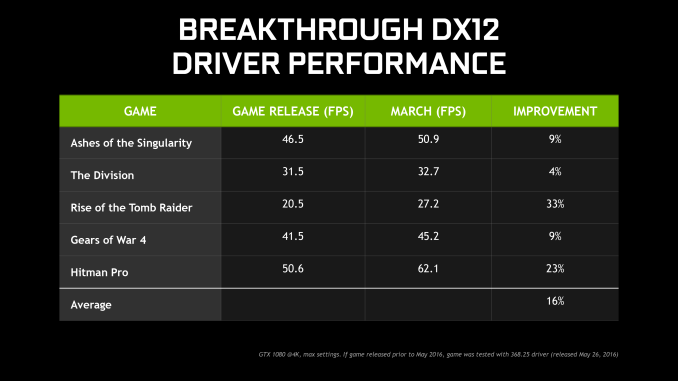The NVIDIA GeForce GTX 1080 Ti Founder's Edition Review: Bigger Pascal for Better Performance
by Ryan Smith on March 9, 2017 9:00 AM ESTDriver Performance & The Test
Alongside the launch of the GTX 1080 Ti, NVIDIA is also touting the performance of their drivers. For most users who have been regularly updating their drivers to begin with, I don’t think there’s anything too surprising here. But because of NVIDIA’s talk of driver performance gains, I’ve already seen some confusion here over whether the GTX 1080 Ti launch driver (378.78) is a special performance driver or not. For the record, it is not.
In their presentation, NVIDIA outlined their driver performance gains in DX12 since the launch of various DX12 games, including Ashes of the Singularity, Hitman, and Rise of the Tomb Raider. All of these games have seen performance improvements, but what’s critical here is that this is over the long-run, since the launch of the GTX 1080 and these respective games.
The 378.78 driver in that respect is nothing special. In terms of driver release, NVIDIA is already a few releases into the R378 branch, so any big code changes for this branch have already been released to the public in earlier driver builds.
In any case, for reference purposes, here’s how performance of the GTX 1080 stacks up now compared to performance at launch.
| GeForce GTX Driver Performance Gains: July 2016 vs. March 2017 (4K) | |||
| Game | GTX 1080 | GTX 980 Ti | |
| Rise of the Tomb Raider |
Even
|
Even
|
|
| DiRT Rally |
+8%
|
+7%
|
|
| Ashes of the Singularity |
+11%
|
+14%
|
|
| Battlefield 4 |
Even
|
Even
|
|
| Crysis 3 |
Even
|
Even
|
|
| The Witcher 3 |
|
Even
|
|
| The Division* |
-7%
|
-9%
|
|
| Grand Theft Auto V |
+2%
|
Even
|
|
| Hitman (DX12) |
+26%
|
+24%
|
|
As was the case with NVIDIA’s data, the performance gains vary from game to game. Some games have not budged, whereas others like Hitman have improved significantly, and outlier The Division has actually regressed a bit due to some major updates that have happened to the game in the same time period. But at the end of the day, these are performance gains that have accumulated over the months and are already available in the latest drivers from NVIDIA.
The Test
For our review of the GTX 1080 Ti, we’re using NVIDIA’s 378.78 driver.
| CPU: | Intel Core i7-4960X @ 4.2GHz |
| Motherboard: | ASRock Fatal1ty X79 Professional |
| Power Supply: | Corsair AX1200i |
| Hard Disk: | Samsung SSD 840 EVO (750GB) |
| Memory: | G.Skill RipjawZ DDR3-1866 4 x 8GB (9-10-9-26) |
| Case: | NZXT Phantom 630 Windowed Edition |
| Monitor: | Asus PQ321 |
| Video Cards: | NVIDIA GeForce GTX 1080 Ti Founders Edition NVIDIA GeForce GTX 1080 Founders Edition NVIDIA GeForce GTX 980 Ti NVIDIA GeForce GTX 780 Ti AMD Radeon Fury X |
| Video Drivers: | NVIDIA Release 378.78 AMD Radeon Software Crimson 17.3.1 |
| OS: | Windows 10 Pro |











161 Comments
View All Comments
Jon Tseng - Thursday, March 9, 2017 - link
Launch day Anandtech review?My my wonders never cease! :-)
Ryan Smith - Thursday, March 9, 2017 - link
For my next trick, watch me pull a rabbit out of my hat.blanarahul - Thursday, March 9, 2017 - link
Ooh.YukaKun - Thursday, March 9, 2017 - link
/clapsGood article as usual.
Cheers!
Yaldabaoth - Thursday, March 9, 2017 - link
Rocky: "Again?"Ryan Smith - Thursday, March 9, 2017 - link
No doubt about it. I gotta get another hat.Anonymous Blowhard - Thursday, March 9, 2017 - link
And now here's something we hope you'll really like.close - Friday, March 10, 2017 - link
Quick question: shouldn't the memory clock in the table on the fist page be expressed in Hz instead of bps being a clock and all? Or you could go with throughput but that would be just shy of 500GBps I think...Ryan Smith - Friday, March 10, 2017 - link
Good question. Because of the various clocks within GDDR5(X)*, memory manufacturers prefer that we list the speed as bandwidth per pin instead of frequency. The end result is that the unit is in bps rather than Hz.* http://images.anandtech.com/doci/10325/GDDR5X_Cloc...
close - Friday, March 10, 2017 - link
Probably due to the QDR part that's not obvious from reading a just the frequency. Thanks.